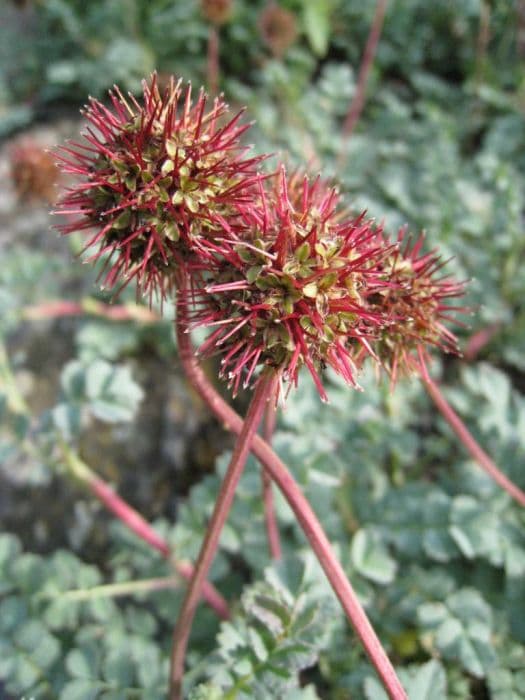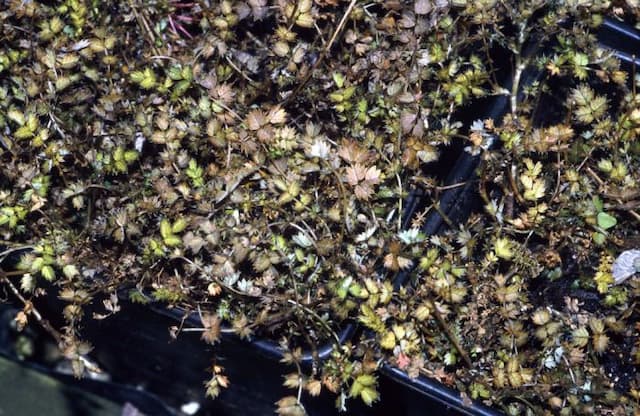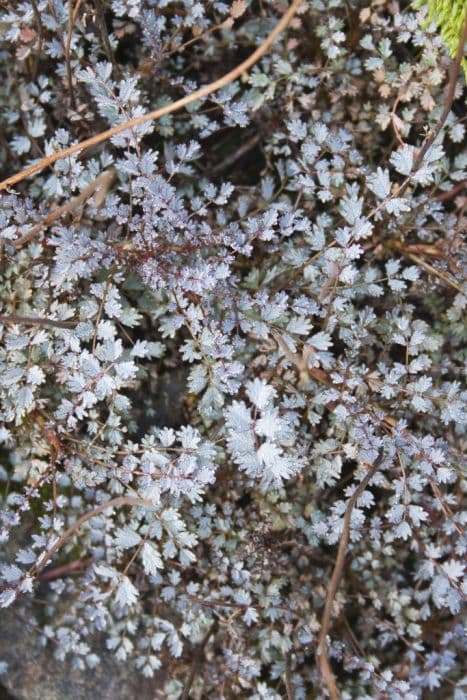Paul's Scarlet Climber Rosa 'Paul's Scarlet Climber' (Cl/ra)

ABOUT
Rosa 'Paul's Scarlet Climber' is known to gardeners simply as a climbing rose. This plant is characterized by its vigorous growth habit and the climbing stems that are perfect for training along fences, walls, or trellises. Its branches feature numerous thorns that help it grip onto supporting structures. The foliage of this climbing rose is usually lush and green, providing a striking backdrop for its blooms. The leaves are compound with oval-shaped leaflets that have serrated edges and a glossy surface. The blooms of the 'Paul's Scarlet Climber' are the true showstoppers, coming in clusters that create a mesmerizing effect when covering the plant. These flowers are double, meaning they have multiple layers of petals, and they present a vivid scarlet red color. The blossoms often have a ruffled appearance and are known for their light, pleasing fragrance. These roses typically flower in late spring to early summer and may have a repeat blooming cycle, which can extend their showy display into the fall months under ideal conditions. The plant is also adorned with occasional rose hips after the flowering period, which are seed-containing structures that can add additional visual interest. Overall, the 'Paul's Scarlet Climber' is beloved for its stunning floral display and its ability to transform vertical spaces in the garden.
About this plant
 Names
NamesFamily
Rosaceae
Synonyms
Paul's Scarlet Climber, Climbing Rose
Common names
Rosa 'Paul's Scarlet Climber'.
 Toxicity
ToxicityTo humans
The climbing rose is generally considered non-toxic to humans. However, as with most plants, there are potential risks if ingested in large quantities. Ingesting parts of the climbing rose, such as leaves or petals, typically does not result in poisoning. Nevertheless, individuals with sensitive stomachs may experience mild gastrointestinal upset if large amounts are consumed. It is always advisable to exercise caution and avoid eating plants not meant for consumption to prevent any possible negative reactions.
To pets
The climbing rose is not toxic to pets. Dogs and cats can occasionally chew on the leaves or petals without severe consequences. However, it is worth noting that the thorns can pose a physical hazard, potentially causing injuries to a pet's mouth, throat, or paws. While the climbing rose doesn't cause poisoning, ingestion of significant amounts of plant material might result in mild gastrointestinal upset in some pets due to the fiber content. Owners should discourage their pets from chewing on these plants to prevent any accidental injuries or digestive discomfort.
 Characteristics
CharacteristicsLife cycle
Perennials
Foliage type
Deciduous
Color of leaves
Green
Flower color
Scarlet
Height
10-14 feet (3-4.2 meters)
Spread
6-10 feet (1.8-3 meters)
Plant type
Climber
Hardiness zones
6
Native area
Cultivar
Benefits
 General Benefits
General Benefits- Aesthetic Appeal: The plant adds vibrant color and beauty to gardens with its scarlet, semi-double flowers that bloom profusely in the early summer.
- Vertical Interest: As a climbing rose, it can be trained on walls, trellises, arbors, and fences, adding height and dimension to garden spaces.
- Scent: The flowers can emit a mild and pleasant fragrance, enhancing the sensory experience of a garden.
- Habitat for Wildlife: It can attract beneficial insects, including pollinators like bees which are essential for the health of a garden ecosystem.
- Privacy Screen: When grown on structures, it can create a natural screen, offering privacy as well as a decorative element to the area.
- Versatility: The plant is suited to a variety of garden styles, including cottage gardens, formal gardens, and can also be used in container gardening.
- Long Blooming Period: With proper care, this rose can have a prolonged blooming season, providing long-lasting color in the landscape.
 Medical Properties
Medical Properties- This plant is not used for medical purposes.
 Air-purifying Qualities
Air-purifying QualitiesThis plant is not specifically known for air purifying qualities.
 Other Uses
Other Uses- Rosa 'Paul's Scarlet Climber' can be used in crafting and as a natural dye, providing a delicate pink to soft red hue for fabrics and yarns.
- The fallen petals can serve as a biodegradable confetti for outdoor celebrations, offering a more environmentally friendly option than synthetic confetti.
- As a natural source of fragrance, the petals of Rosa 'Paul's Scarlet Climber' can be distilled to create homemade perfumes or scented waters.
- Dried petals can be incorporated into homemade potpourri mixes to subtly scent indoor spaces.
- Petals can be used in the making of rose water for culinary purposes, infusing desserts and drinks with a floral note.
- The thorns of the climber can be carefully harvested and used as natural spikes in garden security measures to deter animals and intruders from scaling fences.
- Rose hips, the fruit of the plant, can be used to make a natural pigment for eco-friendly art projects.
- Its sturdy canes can be used in crafting for making items like rustic trellises or supporting structures for other plants.
- Rose petals can be used to add natural color to homemade candles, imparting a light aroma as well as visual appeal.
- The rose's strong visual presence can be utilized in the art of photographic composition, where the rich hues can add depth to floral photography.
Interesting Facts
 Feng Shui
Feng ShuiThe climbing rose is not used in Feng Shui practice.
 Zodiac Sign Compitability
Zodiac Sign CompitabilityThe climbing rose is not used in astrology practice.
 Plant Symbolism
Plant Symbolism- Love and Passion: The Paul's Scarlet Climber, being a variety of rose, inherently symbolizes love and deep affection. Its rich scarlet blooms evoke a sense of intense emotional connection and romantic devotion.
- Beauty and Perfection: Roses are traditionally associated with beauty, and the vibrant scarlet hue of these blossoms conveys a sense of striking perfection and aesthetic appeal.
- Courage and Respect: A deeper red rose such as the Paul's Scarlet Climber can also symbolize admiration, respect, and courage, acknowledging the boldness of the color and its historical ties to bravery.
- Renewal and Rejuvenation: As a climbing rose that re-blooms through the season, it signifies renewal and the rejuvenation of spirit, mirroring the cycles of growth and rebirth in nature.
 Water
WaterThe climbing rose 'Paul's Scarlet Climber' requires consistent moisture, so it should ideally be watered once a week with about 1 to 1.5 gallons of water if there is no significant rainfall. During hot and dry periods, water twice a week. Make sure to water deeply and directly at the base of the plant to encourage deep root growth and reduce the risk of leaf diseases. It is crucial to avoid overhead watering to keep the foliage dry and prevent fungal diseases.
 Light
Light'Paul's Scarlet Climber' roses prefer full sun conditions for best growth and bloom production. They should receive at least 6 hours of direct sunlight daily. A spot that provides morning sun with some afternoon shade is ideal to protect the flowers from intense afternoon heat, which can fade the colors.
 Temperature
Temperature'Paul's Scarlet Climber' roses thrive in temperatures ranging between 55°F and 85°F. They can survive winter temperatures down to about 20°F, but may need protection if temperatures drop further. It's important to avoid planting in areas where temperatures exceed 90°F for extended periods, as this can stress the plant and inhibit flowering.
 Pruning
Pruning'Paul's Scarlet Climber' roses should be pruned to maintain shape, remove dead wood, and encourage flowering. Prune in late winter or early spring, before the plant breaks dormancy. Remove any dead or diseased canes, thin out crowded areas to improve air circulation, and cut back remaining canes by about one third. The best time for major pruning is after the plant has been dormant but just before new growth starts.
 Cleaning
CleaningAs needed
 Soil
SoilThe best soil mix for a climbing rose, such as 'Paul's Scarlet Climber', should be rich, well-draining, and loamy with a pH between 6.0 and 7.0. Amend soil with organic matter like compost and a balanced fertilizer before planting.
 Repotting
Repotting'Paul's Scarlet Climber' roses are typically grown in the ground and do not require repotting. If planted in containers, repot every 2-3 years to refresh the soil and accommodate root growth.
 Humidity & Misting
Humidity & Misting'Paul's Scarlet Climber' roses thrive best in average outdoor humidity conditions and do not require specific humidity adjustments, making standard outdoor conditions ideal.
 Suitable locations
Suitable locationsIndoor
Provide full sun, suitable support for climbing, and good air circulation.
Outdoor
Plant in full sun, ensure rich soil, adequate water, and support for climbing.
Hardiness zone
5-9 USDA
 Life cycle
Life cycle'Paul's Scarlet Climber' is a variety of climbing rose that starts its life cycle when the dormant bare-root plant or potted specimen is planted in well-draining soil in an area with full to partial sun exposure. The plant begins to grow leaves and stems in spring, using energy stored in its root system. As it matures, it develops long, arching canes with thorns, which are often trained against a support structure. Blooming typically starts in late spring or early summer and can continue in flushes throughout the growing season, with clusters of vivid, double, scarlet flowers adorning the plant. After flowering, if the faded blooms are not deadheaded, it may produce small, ornamental fruit called hips. In autumn, the rose enters dormancy, with foliage dying back in colder climates, and then it resumes growth the following spring, completing its perennial cycle.
 Propogation
PropogationPropogation time
Early Spring
The most popular method of propagating Rosa 'Paul's Scarlet Climber', commonly known as Paul's Scarlet Climbing Rose, is through softwood cuttings. This technique is ideally carried out in the late spring or early summer when the rose's new growth is still flexible but beginning to firm up. To propagate, a gardener would take a cutting of about 6-8 inches (15-20 cm) long from a vigorous, healthy cane, ensuring it has several leaves and at least two to three nodes. The lower leaves are removed, and the cut end is often dipped in a rooting hormone to encourage root development. The cutting is then planted in a well-drained soil mix and kept in a warm, humid environment with indirect light. A plastic bag can be placed over the cutting to retain humidity, and within several weeks, the cutting should develop roots and can eventually be transplanted outdoors.









